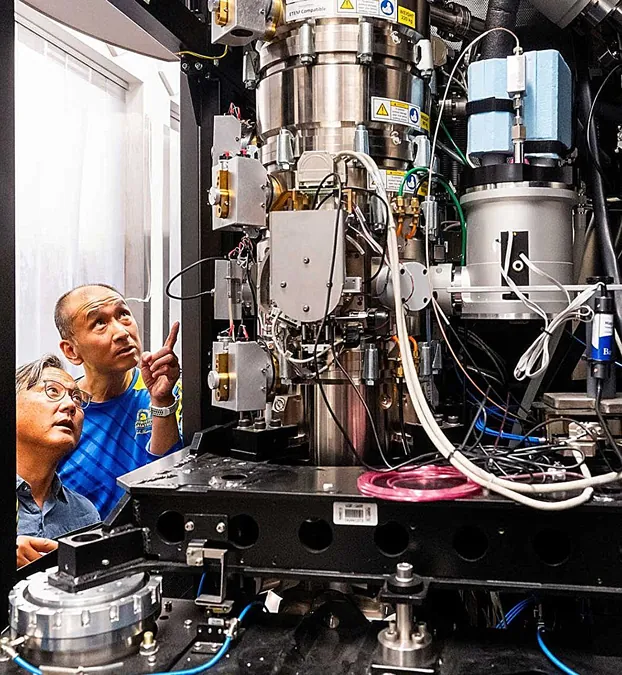
Groundbreaking Discovery: How TGF-Beta Communicates While Bound to Cell Membranes!
2024-09-16
Author: Mei
Groundbreaking Discovery: How TGF-Beta Communicates While Bound to Cell Membranes!
For years, the scientific community has held a deep-rooted belief that TGF-Beta, a pivotal signaling protein influencing numerous cellular processes—from embryonic development to cancer progression—could only fulfill its role once it escaped its binding state, famously likened to a straitjacket.
However, a revolutionary study conducted by researchers at UC San Francisco (UCSF) has challenged this long-standing perception. Utilizing the cutting-edge technology of cryogenic electron microscopy (cryo-EM), which allows for the creation of dynamic three-dimensional models of molecules with atomic clarity, these scientists have uncovered that TGF-Beta possesses remarkable agility.
Rather than being entirely immobilized, TGF-Beta has the ability to perform subtle movements within its bound state, extending portions of itself to activate neighboring receptors—even while tethered to the cell membrane. This groundbreaking revelation, published in the renowned journal *Cell* on September 16, not only overturns decades of established dogma but also presents exciting implications for therapeutic developments, particularly in the realm of cancer treatment, including the notoriously tricky checkpoint inhibitors.
In a fascinating twist, the research team, led by key figures Yifan Cheng, Ph.D., and Stephen Nishimura, M.D., unearthed that TGF-Beta could signal to its receptor while still ensconced within its latency-associated protein (LAP) "straitjacket." This finding shatters previous assumptions that TGF-Beta must be released from LAP to engage in cellular communication, a notion that suggested a significant malfunction could occur in essential biological processes, such as healthy cell proliferation.
In an even more astonishing experiment, the researchers created a permanent link between TGF-Beta and its LAP in mice, demonstrating that the protein could still perform its signaling functions despite being bound. This result further underscored the flexibility and versatility of TGF-Beta’s interaction with receptors.
The process behind these discoveries involved the innovative use of cryo-EM to visualize TGF-Beta’s interactions. By swiftly freezing a mixture of proteins and capturing hundreds of thousands of images, the researchers were able to analyze how TGF-Beta behaved while restrained. Previous studies typically focused on the clearest, most definitive structures, overlooking the subtleties in molecular motion—the intriguing areas, often dismissed as 'blurry,' which could hold the key to understanding TGF-Beta's unique signaling capabilities.
The team’s meticulous approach involved stabilizing various configurations of LAP and TGF-Beta to explore their interactions with receptors. They discovered that, despite the constraints of LAP, TGF-Beta could still extend enough of its structure to interact with its receptor, albeit momentarily. By examining the dynamics of TGF-Beta in this manner, they provided fresh insights into its signaling mechanisms that could reshape our understanding of not just TGF-Beta, but other signals that mediate cellular communication.
With these findings, UCSF’s Cheng and Nishimura hope to inspire new ways of thinking among scientists across disciplines, emphasizing the need to explore molecular dynamics rather than rigid forms. They suggest there are still countless discoveries waiting to be made using advanced cryo-EM techniques, potentially unlocking new avenues in the fields of disease modeling and structural biology.
This exciting revelation opens doors to understanding both the intricate language of cellular signaling and the ways we might better tackle diseases such as cancer in the future. As research continues, one thing is clear: the world of molecular biology may be richer and more complex than we ever imagined!



 Brasil (PT)
Brasil (PT)
 Canada (EN)
Canada (EN)
 Chile (ES)
Chile (ES)
 Česko (CS)
Česko (CS)
 대한민국 (KO)
대한민국 (KO)
 España (ES)
España (ES)
 France (FR)
France (FR)
 Hong Kong (EN)
Hong Kong (EN)
 Italia (IT)
Italia (IT)
 日本 (JA)
日本 (JA)
 Magyarország (HU)
Magyarország (HU)
 Norge (NO)
Norge (NO)
 Polska (PL)
Polska (PL)
 Schweiz (DE)
Schweiz (DE)
 Singapore (EN)
Singapore (EN)
 Sverige (SV)
Sverige (SV)
 Suomi (FI)
Suomi (FI)
 Türkiye (TR)
Türkiye (TR)
 الإمارات العربية المتحدة (AR)
الإمارات العربية المتحدة (AR)